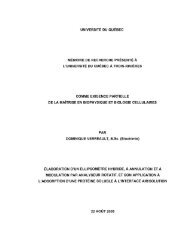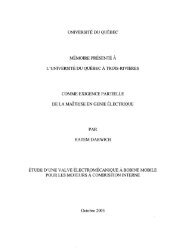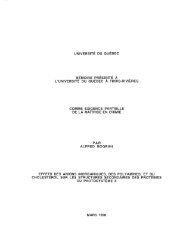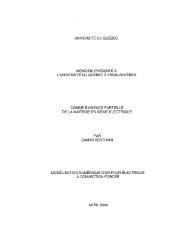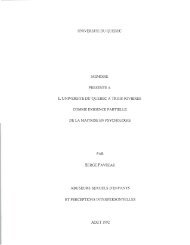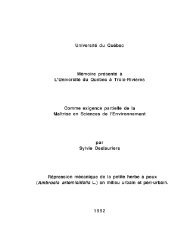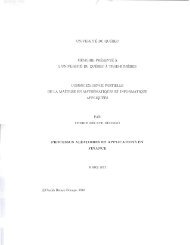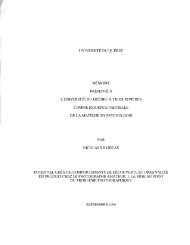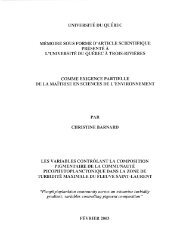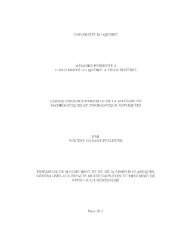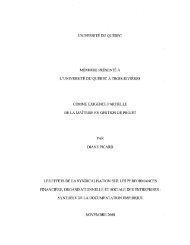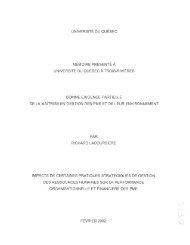Télécharger (4Mb) - Université du Québec à Trois-Rivières
Télécharger (4Mb) - Université du Québec à Trois-Rivières
Télécharger (4Mb) - Université du Québec à Trois-Rivières
You also want an ePaper? Increase the reach of your titles
YUMPU automatically turns print PDFs into web optimized ePapers that Google loves.
The substitution rate of peroxide by a<br />
re<strong>du</strong>cing agent with the costs of bleaching<br />
chemicals given in Table l, is 2.1 for<br />
hydrosulfite, and 17.3 for borohydride .<br />
Figure 16 gives the charge of the<br />
re<strong>du</strong>cing agents, on a logarithmic scale, as a<br />
function of the peroxide consurned to obtain<br />
an iso brightness of 77% for the three-stage<br />
bleaching sequences evaluated in this study.<br />
With no re<strong>du</strong>cing agent, 2.26% of peroxide<br />
consumed is needed to reach this brightness<br />
level (asymptote represented by the dotted<br />
line). The grey area represents the various<br />
combinations of charges of the bleaching<br />
chemicals under which a brightness value of<br />
77% iso could be obtained while the<br />
replacement. of peroxide by the re<strong>du</strong>cing agent<br />
is economical, e.g. re<strong>du</strong>ces the bleaching<br />
costs. This corresponds to charges where the<br />
substitution rate is greater than 2.1<br />
(hydrosulfite) and 17.3 (borohydride). It<br />
can be seen from this figure that the<br />
sequences HPP and BPP compared to PHP, PPH<br />
and PBP are closer to the are a where the<br />
substitution is economical. Upon optimization<br />
work, it is possible that the REP<br />
process can be economical.<br />
CONCLUSION<br />
The conclusions of this work are as<br />
follows:<br />
1. The use of a re<strong>du</strong>cing agent (R) with<br />
peroxide {Pl in a two-stage bleaching<br />
sequence yields higher brightness levels than<br />
peroxide in one stage at a constant charge of<br />
peroxide consumed (e.g. RP, PR > P) (with the<br />
exception of PB).<br />
2. The brightness gains are higher with the<br />
sequence PH compared to the sequence HP.<br />
3. The brightness gains with the sequence BP<br />
are higher than those obtained with ' the<br />
sequence PB.<br />
4. The use of a re<strong>du</strong>cing agent<br />
peroxide {Pl decreases the yellow<br />
the pulps more appreciably th an<br />
alone at a constant charge of<br />
consumed. (e.g. RE, PR > P)<br />
(R) with<br />
shade of<br />
peroxide<br />
peroxide<br />
5. The decrease of the yellow shade is<br />
similar for the sequences PH, HP and BP.<br />
6. The costs of the sequences BP and PB are<br />
about 150% higher than those for single stage<br />
peroxide bleaching (brightness of 77%).<br />
7. The costs<br />
similar and<br />
for single<br />
brightness).<br />
of the sequences HP and PH are<br />
are about 17% higher than those<br />
stage peroxide bleaching (77%<br />
8 . The sequence PH is superior to the other<br />
two-stage sequences considering the<br />
brightness gains and the re<strong>du</strong>ction of the<br />
yellow shade of the pulps while the bleaching<br />
costs involved are reasonable.<br />
638/ TAPPI Proceedings<br />
9. The use of a re<strong>du</strong>cing agent (R) with<br />
peroxide {Pl in a three-stage sequence allows<br />
one to reach higher brightness levels than<br />
those obtained with two-stage peroxide<br />
bleaching (PP). (e.g. REP, PRP > PP)<br />
10. The brightness gains of the sequence REP<br />
are superior to those obtained with the<br />
sequence PRE. (e.g. REP > PRE)<br />
11. The use of a re<strong>du</strong>cing agent (R) with<br />
peroxide in a three-stage bleaching process<br />
removes pulp yellowness more effectively than<br />
with peroxide only in a two-stage bleaching<br />
process.<br />
12. The use of the re<strong>du</strong>cing agent in the<br />
first stage of the three-stage bleaching<br />
process is more efficient at re<strong>du</strong>cing pulp<br />
yellowness. (e.g. REP > PRE, PPH)<br />
13. The cost of the sequences BPP and PBP are<br />
at least twice the cost of the two-stage<br />
peroxide bleaching process (PP).<br />
14. The cost of the sequences HPP and PHP are<br />
on the average approximately 20% higher than<br />
the cost of those for two-stage peroxide<br />
bleaching (77% iso).<br />
15. The cost for HPP is about 11% superior to<br />
the sequence PP, but is 15% inferior to the<br />
sequence PPH.<br />
16. The sequence BPH is the most efficient<br />
three-stage sequence considering the brightness<br />
gains obtained, the re<strong>du</strong>ction of the<br />
yellow shade of the pulps. The cost involved<br />
are approximately 123% superior to these for<br />
a two-stage peroxide bleaching process (PP).<br />
17. On the overall, the sequence HPP is<br />
superior to the other three-stage sequences,<br />
considering the brightness gains and the<br />
re<strong>du</strong>ction of the yellow shade of the pulps,<br />
while the bleaching costs are reasonable.<br />
EXPERIMENTAL<br />
A Spruce/Balsam chemithermomechanical<br />
pulp (CTMP) of an Eastern Canadian newsprint<br />
mill has been used in this work. A detailed<br />
description of experimental proce<strong>du</strong>res<br />
followed for pulp pretreatment, bleaching,<br />
interstage treatment, sheetmaking and<br />
brightnesq/cotor measurements can be found<br />
elsewhere(1-4. The charges of chemicals ,<br />
temperature, time, consistency and pH are<br />
given in Table 2 for one and two-stage<br />
bleaching, and in Table 3 for three-stage<br />
bleaching.<br />
ACKNOWLEDGEMENTS<br />
The technical<br />
Sophie Janknecht,<br />
Jean de Villers,<br />
Nathalie Barbe,<br />
Michel Provençal and<br />
gratefully acknowledged.<br />
assistance of<br />
Christian Viel,<br />
François Tremblay,<br />
Mavi Pizzolitto,<br />
Paulette Gauvin is<br />
189



